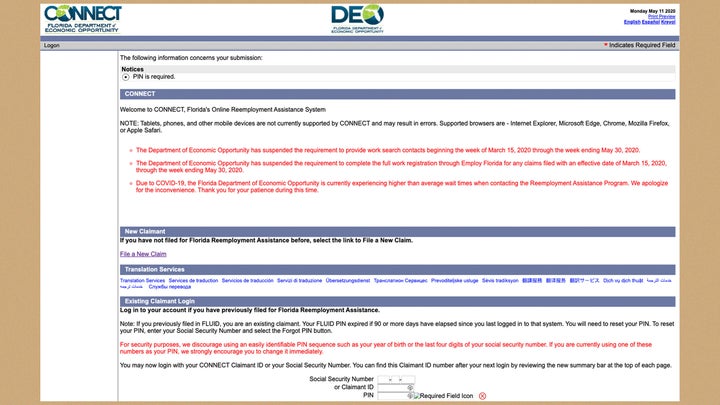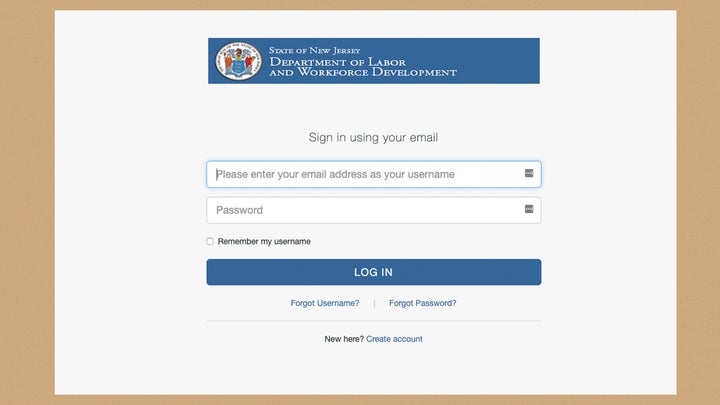As soon as Diane completed her unemployment application, she knew something was wrong.
Each time the 65-year-old disabled North Carolina resident reached the final page of the Pandemic Unemployment Assistance (PUA) application, the website wouldn’t let her select “submit.” But when she, like many others, contacted the state’s Division of Employment Security for help, she reached the same voicemail over and over: All of their lines were busy, no one could talk to her and she would have to try calling back later. Click.
By her 20th call, someone eventually picked up ― an employee representing North Carolina’s call center but located in a different state. Diane said the employee seemed almost as confused as she was with the state’s online unemployment application for claims involving the coronavirus pandemic. Diane realized the next day that the employee had filled out her application incorrectly. She’s tried calling back but hasn’t been able to get another person on the line again.
“I’m just going to have to keep calling,” said Diane, who was hesitant to let HuffPost publish her last name for fear it would further jeopardize her payment. “I don’t have any other way forward. This money would have bid me some time to find other solutions, but now I’m just stuck calling one day after another.”
Plenty of other unemployment applicants are experiencing technical issues as they try to file. In North Carolina, more than one-fifth of its working population is now unemployed. And across the country, 33 million people have lost their jobs amid the COVID-19 pandemic ― a 14.7% unemployment rate.
For those who have been working on the technology behind state unemployment websites, the fact that they’re widely dysfunctional right now is not a surprise.
“Unemployment systems are designed to deal with a few thousand applicants a week,” said Cyd Harrell, a civic designer who has worked as a consultant to state governments who want to create accessible websites. “Now they’re suddenly dealing with hundreds of thousands of people in a heightened state of emergency. It’s important to understand that access and ease aren’t always aligned with government policy.”
A Structure Built On Rickety Old Architecture
In Florida, thousands of residents discovered that their unemployment applications have been marked ineligible, but the site provided no supporting documentation as to why or information on how to appeal.
Lauren Koff, a 27-year-old resident of Port St. Lucie, Florida, has been calling the Florida Department of Economic Opportunity (DEO) every day to figure out why she’s ineligible. Koff had been working at a nonprofit until April 6. She’s been furloughed but isn’t sure when she’ll be able to get back to work.
“When I finally got someone on the line, they told me that hundreds of other people had been calling,” Koff said. “They told me it was a possible computer glitch and to just be patient.”

But Koff said it’s hard to remain patient since she’s had to ask relatives to help her cover next month’s mortgage. And Diane, who is already a month behind rent herself, says she’s used up all of her savings.
“There’s just no hope,” Koff says. “Most of my friends have never been unemployed before or have even had to use this system.”
Harrell, who is the former head of product for the nonprofit tech group Code of America, said that a major contributing factor is funding.
“Advancing your website is expensive, and it’s ongoing,” Harrell said. “And for quite a while, the government would fund things like websites in a capital expense model. You would do it, and it would be done, and you would assume that you didn’t need to work on it for a while.”
There are numerous factors that can affect how smoothly a site works. On the front end, websites should be sleek and easy enough to understand that a user can intuitively know how to move around and access resources. Meanwhile, websites should be equipped on the back end to have enough surge capacity to handle numerous users at one time and to properly run without glitches.
State government websites that were once state-of-the-art have not been updated, while the private sector has enlisted design teams to keep websites from having even the slightest lag in buffering or awkward conversion to mobile.
Harrell believes that state governments’ bureaucratic process was only compounded by the 2008 recession, which depleted already limited state budgets. By the time she began working in civic design in 2012, as one of the first to specialize in working directly with government entities, usability and design weren’t on anyone’s radar.
“When I started, design wasn’t a big consideration,” Harrell said. “It really wasn’t a big part of the conversation.”
A year later, the U.S. government experienced one of its earliest, and probably most notorious, technical fumbles. On Oct. 1, 2013, the Obama administration introduced Healthcare.gov to disastrous results. The Affordable Care Act website featured issues on both the front and back end. When it crashed within a few hours of its debut, users reported that drop-down menus wouldn’t load and that information on the website was inaccurate. Only six applications were successfully filed through the site on its first day.
In response, tech startups Ad Hoc and Nava were enlisted to fix the website.
“Healthcare.gov instigated public conversation on how technical failure can prevent access to basic services,” said Sha Hwang, the chief operating officer and founder of Nava. “This was a case where the interface and design of the website was actually blocking people from enrolling into health care services.”
Despite that high-profile failure, most state government websites still have not changed. New Jersey Gov. Phil Murphy (D) made headlines in April when he asked tech programmers fluent in the programming language COBOL to help update the state’s unemployment website. That software reached its peak in the ’90s.

Organizations such as the U.S. Digital Response, which provides technical support to federal agencies, has started matching voluntary tech engineers and programmers to states whose websites need the most help to deal with the pandemic.
“Before the pandemic, there was already record-low unemployment,” said the group’s unemployment insurance team lead, Reshma Khilnani. “But the mainframes weren’t stressed, and there wasn’t a lot of attention needed to the systems. And then suddenly millions of applications came in, and [these websites] became really hard to modify and keep online while under that much stress. It’s just all kinds of chaotic.”
Though Khilnani could not reveal which other states are still using COBOL, she could confirm that several still do.
“Modern software development is all about using the cloud or Javascript,” Khilnani says. “None of these are compatible with COBOL, it’s a completely separate universe. ... It’s hard to change, and a lot of states haven’t made that change.”
The Move to Mobile Usage
State unemployment websites also struggle when it comes to compatibility on smartphones. In a study published in April from the Information Technology and Innovation Foundation, 86% of state unemployment websites failed at least one benchmark for the speed or user-friendliness of its mobile site.
This is particularly concerning when you consider that Black and Latino Americans are more likely than whites to rely on a smartphone rather than a personal computer.
“It’s frustrating that we haven’t seen improvements that are obtainable,” said Michael McLaughlin, a research analyst and co-author of the study. “Even in the private sectors, their websites are performing much, much better.”
The study found that 45 states were unprepared for increased traffic from COVID-19. Twenty-six sites have reportedly crashed due to a surge in website traffic, and 19 states did not meet accessibility standards for those who are visually impaired or might rely on screen readers.
The results echo a similar study released from ITIF three years ago. It showed that 9 out of 10 government websites failed to meet the benchmark standards each state had outlined.
“This has been happening for years, every day, to people who don’t have as much political and social capital,” said Harrell. “It’s not just an epidemic problem, and it shouldn’t just be visible when it’s now affecting a large chunk of middle-class people.”
In North Carolina, Diane was eventually approved and received a direct deposit of $600. In Florida, Koff was finally able to get a state representative on the phone a week after initially being marked as ineligible. Her application has now been marked as active and she’s waiting for verification from her employer. She’s even received her first PUA check but is still waiting to hear back about her additional unemployment benefits.
At the very least, it’s given her some peace of mind.
“It feels like my sanity is finally being restored,” Koff says. “But it hasn’t ended. I’m still missing some of that income, and it’s still a constant battle.”
- Stay up to date with our live blog as we cover the COVID-19 pandemic
- What happens if we end social distancing too soon?
- What you need to know about face masks right now
- Will there be a second stimulus check?
- Lost your job due to coronavirus? Here’s what you need to know.
- Why it takes so long to make a coronavirus vaccine
- Parenting during the coronavirus crisis?
- The HuffPost guide to working from home
- What coronavirus questions are on your mind right now? We want to help you find answers.
- Everyone deserves accurate information about COVID-19. Support journalism without a paywall — and keep it free for everyone — by becoming a HuffPost member today.

